Seeing Red Revisited
Every week for five consecutive weeks, I am revisiting a series of columns I wrote about color philosophy back in 2003. I started with white ("The Great White Way Revisited"), then did blue ("True Blue Revisited"), followed by black ("In the Black Revisited"), and today I'm up to red.
For each of these five columns, I will answer the six questions I first posed in the original articles and present a few updated thoughts from the last twelve years. Here are the six questions:
• What does the color desire? What is its end goal?
• What means does the color use to achieve these ends?
• What does the color care about? What does the color represent?
• What does the color despise? What negatively drives the color?
• Why does the color like its allies and hate its enemies?
• What is the color's greatest strength and biggest weakness?
As this is the fourth week, I'm hoping you get how this goes.
What does the color desire? What is its end goal?
Red wants freedom.
Everyone seems preoccupied with the meaning of life. Red's not, because red already knows the answer. You see, your heart tells you what it needs in order to be fulfilled. All you have to do is listen to it and act accordingly. It's not a mystery. You are literally bombarded with constant feelings that guide you down the correct path. The problem is all the other colors ignore the message.
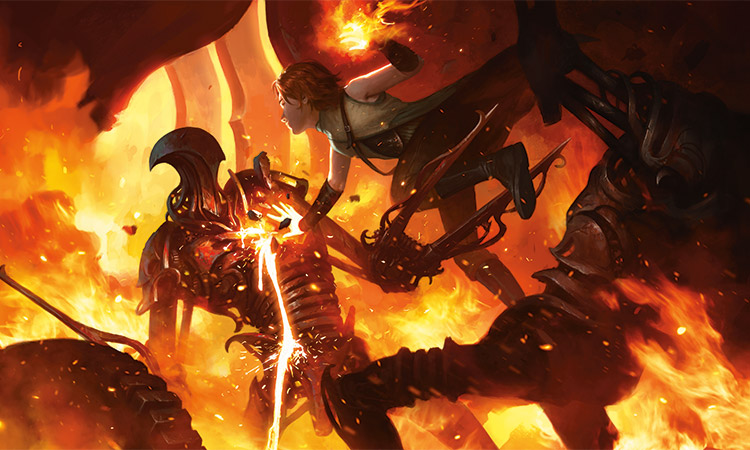
Fiery Impulse | Art by Daarken
Life's an adventure, and it's up to each individual to experience it. The key is to embrace your emotions and let them guide you. If you're happy, laugh. If you're sad, cry. If you're angry, hit something. If you're scared, run away. Listen to your inner voice and you will have the opportunity to experience all that life has to offer.
Too many individuals live their life questioning choices they've made. Not red. Red lives in the moment; red is spontaneous; red embraces every adventure put before it. Red knows that on its deathbed, it will look back on a fulfilled life with no regrets. That's all red wants—the ability to live life doing what it needs to.
This doesn't mean red is alone. Quite the opposite actually. Part of living life is embracing relationships. Red knows passion and loyalty and camaraderie and lust. When red bonds with another, it bonds strongly and fiercely. Whether a lover or a friend, red is someone who will always be there when you need them. Well, unless, life has taken them somewhere else for some length of time—but then when they get back, they're definitely going to be there for you.
To outsiders, red might seem a bit chaotic; but that's only because others can't see what's in red's heart. They cannot feel red's emotions guiding them. Living life to its fullest takes a lot of dedication and perseverance, but red is always up to the task.
What means does the color use to achieve these ends?
Red is a color of action. If you want something, you have to constantly be taking steps towards your goal. You can't cross the finish line if you're not in the race. Red achieves its goals because it prioritizes making things happen and it takes the steps to ensure that they will.
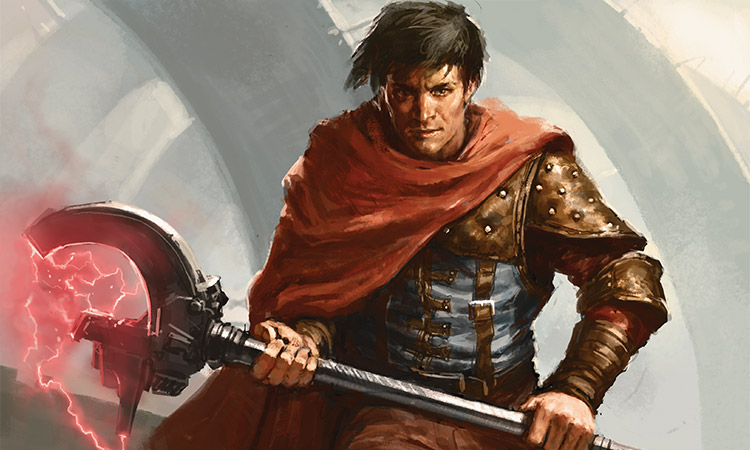
Mage-Ring Bully | Art by Karl Kopinski
A big part of this is red being very attuned to its feelings. Red always knows the next action it has to take, because it listens to what its heart is instructing it to do. Red is never without direction or guidance. Now, that direction can change—sometimes quickly—because the heart is fickle, but red is always ready to act.
Red has a few different tools at its disposal. First, it has the resources to be destructive when it needs to be. If something is causing red problems, red can blow it up. Or burn it down. Or destroy it through a variety of different means. Red's not afraid to get its hands dirty, and it never backs down from a challenge.
Red also has speed on its side. Red's impulsiveness allows it to act instantaneously, and it doesn't ever need time to think through its actions. Red can hit fast and strong before others can even prepare for what's coming.
Red is good at manipulating emotions. Just as red feels every impulse strongly, it can fan the flames of emotions within others—often to powerful effect.
Red can be very tricky. It has an impish nature that it can tap into, which allows it to interfere with the plans of others.
Red is relentless. As long as red cares about something, it will keep trying until it gets what it needs.
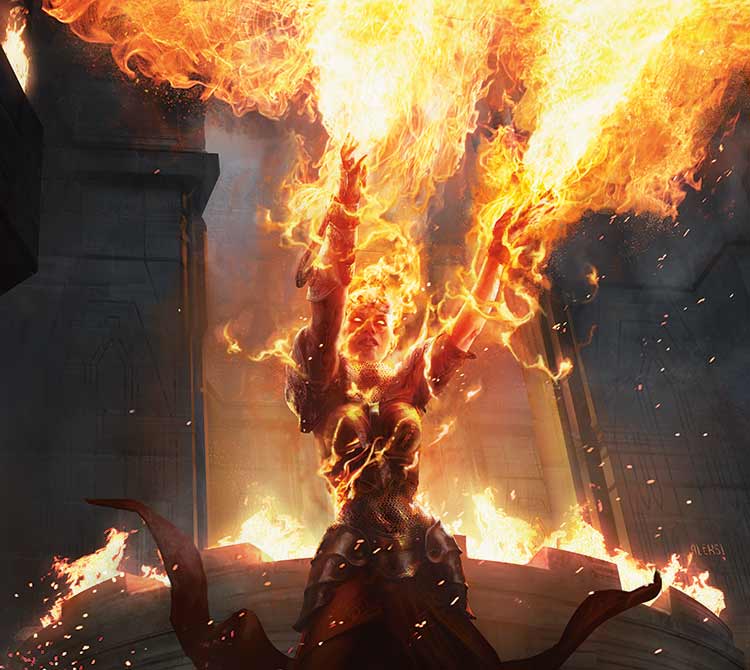
Ravaging Blaze | Art by Aleksi Briclot
Red's focus and energy make it the most driven color. It knows what it wants and it acts on those feelings without the slightest hesitation. Getting between red and what it wants can be very, very dangerous.
What does the color care about? What does the color represent?
Here are some things essential to red:
Emotion—If you're going to follow your heart, that means being in touch with your emotions. And not just some of your emotions, but all of them. Magic is a combat-oriented game, so we obviously focus more on anger and aggressive emotions that make sense in combat. But red is just as swayed by every emotion. Red also doesn't bottle up its emotions, it lets them out. Red loves action, and emotions are great motivators.
Mood Swings—Not only is red focused on emotions, it's always focused on many emotions all at once. This means that red is more prone than any other color to have emotional swings. Red can laugh one moment and be in tears the next. Others might see this as being unfocused and easily distracted, but red feels it's important to always stay in touch with your feelings—and if that means some emotional swings, then that is just what was meant to be.
Impulse—Red doesn't have time for thinking. Thinking takes way too long. Red's competitive advantage is its speed and the ability to make big decisions instantaneously. The way red can accomplish this is by relying on its impulses to make the right call. Your gut is just so much faster than your brain.
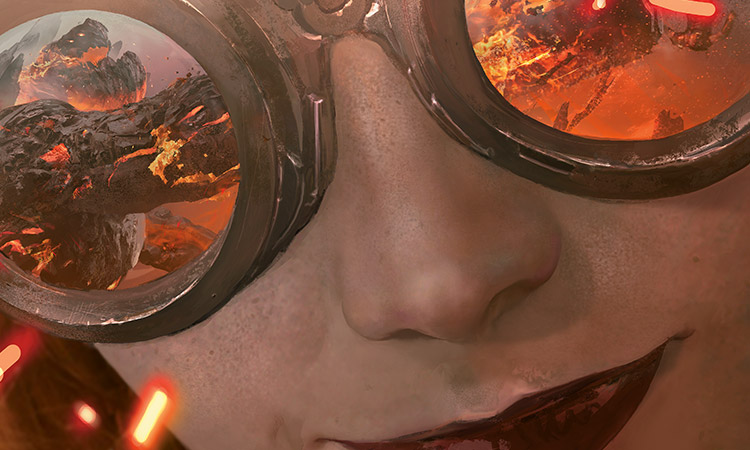
Act on Impulse | Art by Brad Rigney
Might (Solving problems through brawn)—If red has to choose between letting its mind solve a problem and letting its body solve it, red heavily leans towards the latter. Red has a lot of practice using action to get things done.
Violence—Red prefers blunt answers. One blunt answer is physical violence. Someone gets in your way, hit them until they fall down. That usually solves it . . . for now. But that's good enough.
Brutality—Some other colors draw a line between what is acceptable and what is not. Red blurs that line. Red prefers amicable resolutions—but if it finds other, more direct solutions, red has no problem using them.
Destruction—Red likes easy-to-remember plans of action. If a thing is a problem, there's a simple universal answer: Destroy the thing. To red, destruction is an art unto itself, and those who master the art have a lot fewer things bugging them.
Chaos—This is white's word, not red's. Red just wants things to run the way they want to run, and as we're dealing with humans, it's messy. But that mess contains the beauty red sees in the world. Each individual is living the life determined for them, and as different people's lives crash into one another, we start to understand the impact individuals have on the group. It seems disjointed from afar, but as you dig in deep you find that the inconsistencies, the variance, the flaws all add that extra layer of humanity.
Randomness—Life isn't orderly, so why should people act as if it is? Part of finding happiness is recognizing that things don't always happen for a reason; red has embraced randomness as an inevitable component of life.
Spontaneity—Red recognizes that one of the great joys of life is the ability to do what you want to do in the instant you want to do it. In order to allow this to happen as much as possible, red embraces the idea that things don't have to be planned ahead but rather can be created in the moment.
Humor—Red loves to laugh, and as such is the color that most actively creates and appreciates humor. The other four colors all have their own form of humor, but none are as blunt, as broad, or as entertaining as red's.
Mischievousness—Red enjoys doing things to entertain itself. One of those things is messing with other individuals. It's really funny when things don't go as others have planned.
The Elements of Fire and Earth—Red values the volatile side of these natural elements (lightning, fire, earthquakes, mudslides, etc.), and quite often uses them as the source of its direct damage.
Fighting (Brawling)—Red does not back down from a fight, but note that these fights are much more unstructured brawling than any formalized combat.
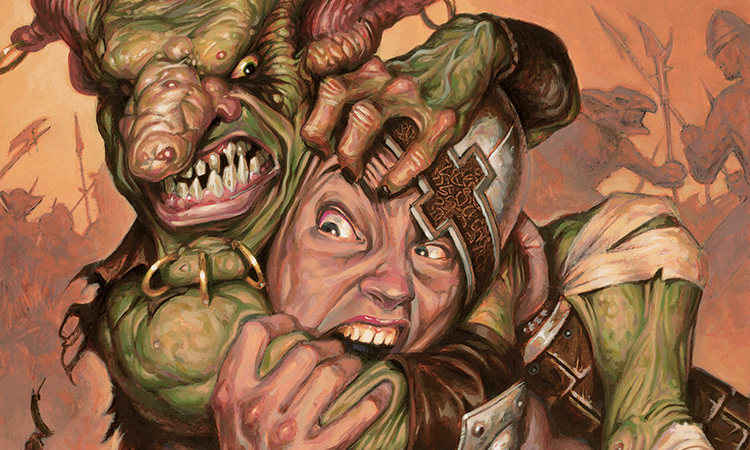
Goblin Piledriver | Art by Matt Cavotta
Romance—Red's a lover and a fighter. Just as red won't back down from a fight, red is also not afraid of letting others know how it feels. Red isn't scared of relationships. It knows that through close bonds with others, some of life's happiest moments happen.
Hedonism—Red embraces following your feelings. Most of the time, that means doing things you want to do because they're things you'd enjoy. Red sees no shame in delivering on this basic need.
Barbarism—The offshoot of valuing action over thought is that many times you act in a more primitive manner.
What does the color despise? What negatively drives the color?
Red doesn't like being frustrated or bored. The first happens when someone tries to inform red that it cannot do what it wants to do. Red's default reaction is to just do it anyway, but if something tries to stop red, red will figure out how to remove the obstacle in its way. Red likes to see itself as an unstoppable force that will just keep taking action until it get what it wants.
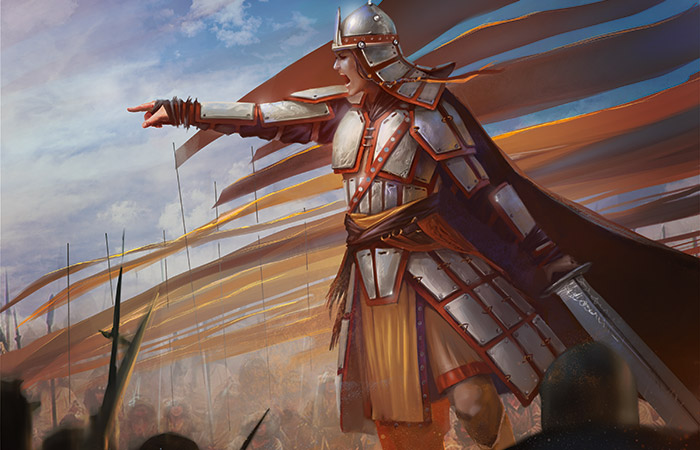
Alesha, Who Smiles at Death | Art by Anastasia Ovchinnikova
Red's other pet peeve is when nothing is happening. Red is a color of action, so anything leading to inaction drives red crazy. Red has no patience nor long-term plan, so the last thing it wants to do is not do anything. Red would much rather fail miserably than sit back and never try.
Why does the color like its allies and hate its enemies?
Red looks at black and sees a color guided by an internal voice, not external ones. Black also values the ability to do what it wants, and it understands the importance of destruction. Black plans and plots a little more than red likes, and is a bit more selfish than even red is comfortable with, but overall black is a color that red can identify with.
Green embraces its instinct and, like red, can act without needing to think about it first. Green has a wild side that red appreciates. Green is also big on "might making right," a concept that red can get behind. Green is a little more orderly than red would prefer and, at times, a bit more serene than red can handle; but it's definitely a color that red feels at home with.
Red looks at white and sees a color that seems to exist solely to complicate things unnecessarily. White's obsession with rules and laws creates system after system designed to prevent red from doing what it wants to do. Even worse, it has the tools to enforce its structure. Scariest of all, white has the means to imprison red, along with the infrastructure to falsely justify such an action. This leads to the worst possible outcome for red: a complete loss of freedom.
Red sees blue as a danger, because blue lives to undercut the value of feelings. If blue had its way, individuals would be emotionless automatons never knowing what it was to experience raw emotions. In addition, blue's mission seems to be to make nothing happen. Blue wants to destroy red's way of life, and bore red to death in the process.
What is the color's greatest strength and biggest weakness?
Red's greatest strength is its ability to know what it wants. Red has purpose and clarity. In addition, red is committed to taking action to get the things it wants. Others might pine for things; red actively takes the steps to acquire them. This drive grants red a passion and speed that can often overwhelm its adversaries. Red's enthusiasm creates an energy that allows it to do amazing things.
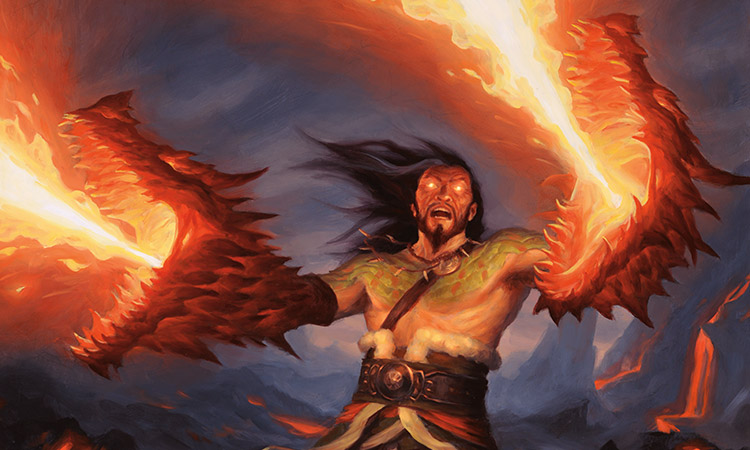
Sarkhan's Rage | Art by Chris Rahn
Red's greatest weakness is an unwillingness to think long-term. Red is very short-sighted, trying to accomplish what it wants right now and seldom thinking of the ramifications of its actions. Red often puts all its eggs in one basket, and if that plan doesn't work out, red can easily get itself in trouble. In addition to all that, red is very bad at taking advice from others, choosing to follow its own path even when everyone around it is saying that disaster awaits.
Examples of Red Characters in Recent Pop Culture
Helena (Orphan Black)
Helena is the clone that acts rather than thinks. You never know what she is going to do, because Helena herself never knows until right before she does it.
Knux (Mad Max: Fury Road)
Throughout the movie, Knux makes decisions moment-to-moment, because he can only plan for his immediate future. Knux is very much driven by his emotions, which leads him to bounce around a lot throughout the film.
Quicksilver (Avengers: Age of Ultron)
Pietro's power is super speed, which allows him to act impulsively a lot faster than a normal human. Even though he has the ability to quickly think things through before he acts, he never does.
All the Emotions (Inside Out)
Joy, Sorrow, Anger, Fear, and Disgust. Each one of them is clearly motivated by a singular emotional impulse (you know, them being emotions and everything), leading them to make reckless decisions that bring all sorts of ramifications.
Mabel Pines (Gravity Falls)
Mabel is completely at the whim of her feelings. Jeopardize the time-space continuum so she has the chance to win a pig at the county fair? Done! She is constantly motivated by her latest crush or current project, which usually has near-disastrous implications for the people around her.
Human Torch (Fantastic Four)
Johnny Storm is figuratively and literally a hot head. He's impulsive, gets in fights, and often acts before he thinks his actions through. Oh yeah, and he lights himself on fire.
Homer Simpson (The Simpsons)
Homer is completely run by his emotions, leaving chaos in his wake. He is the embodiment of short-sighted thinking.
Painting the Town Red
That is the philosophy of red. As always, I would love to hear your thoughts on each week of the color philosophy, either through my email or any of my social media accounts (Twitter, Tumblr, Google+, Instagram).
Join me next week for my fifth and final color philosophy article, covering green.
Until then, follow your heart and have an adventure!
"Drive to Work #248 – 10 Things Every Game Needs – Strategy"
This is the seventh in my "10 Things Every Game Needs" series. In this episode, I talk all about the importance of strategy to a game.
"Drive to Work #249 – Evergreen Keywords"
Many weeks ago, I wrote an article called "Evergreen Eggs & Ham" where I talked about the history of evergreen keywords. This is the podcast about that article, including a correction of an oversight I made in the article.
- Episode 249 Evergreen Keywords (21.0 MB)
- Episode 248 10 Things Every Game Needs – Strategy (20.1 MB)
- Episode 247 Judging (16.3 MB)
- Episode 246 Early Trips (16.1 MB)
- Episode 245 Black/Green (13.9 MB)

